Serpina3n attenuates granzyme B-mediated decorin cleavage and rupture in a murine model of aortic aneurysm
- PMID: 21900960
- PMCID: PMC3186906
- DOI: 10.1038/cddis.2011.88
Serpina3n attenuates granzyme B-mediated decorin cleavage and rupture in a murine model of aortic aneurysm
Erratum in
- Cell Death Dis. 2011;2:e215
Abstract
Granzyme B (GZMB) is a proapoptotic serine protease that is released by cytotoxic lymphocytes. However, GZMB can also be produced by other cell types and is capable of cleaving extracellular matrix (ECM) proteins. GZMB contributes to abdominal aortic aneurysm (AAA) through an extracellular, perforin-independent mechanism involving ECM cleavage. The murine serine protease inhibitor, Serpina3n (SA3N), is an extracellular inhibitor of GZMB. In the present study, administration of SA3N was assessed using a mouse Angiotensin II-induced AAA model. Mice were injected with SA3N (0-120 μg/kg) before pump implantation. A significant dose-dependent reduction in the frequency of aortic rupture and death was observed in mice that received SA3N treatment compared with controls. Reduced degradation of the proteoglycan decorin was observed while collagen density was increased in the aortas of mice receiving SA3N treatment compared with controls. In vitro studies confirmed that decorin, which regulates collagen spacing and fibrillogenesis, is cleaved by GZMB and that its cleavage can be prevented by SA3N. In conclusion, SA3N inhibits GZMB-mediated decorin degradation leading to enhanced collagen remodelling and reinforcement of the adventitia, thereby reducing the overall rate of rupture and death in a mouse model of AAA.
Figures

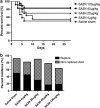
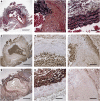
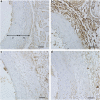

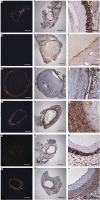
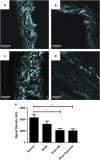
References
-
- Thompson RW. Detection and management of small aortic aneurysms. N Engl J Med. 2002;346:1484–1486. - PubMed
-
- Ailawadi G, Eliason JL, Upchurch GR., Jr Current concepts in the pathogenesis of abdominal aortic aneurysm. J Vasc Surg. 2003;38:584–588. - PubMed
-
- Satta J, Laurila A, Paakko P, Haukipuro K, Sormunen R, Parkkila S, et al. Chronic inflammation and elastin degradation in abdominal aortic aneurysm disease: an immunohistochemical and electron microscopic study. Eur J Vasc Endovasc Surg. 1998;15:313–319. - PubMed
Publication types
MeSH terms
Substances
Grants and funding
LinkOut - more resources
Full Text Sources
Other Literature Sources
Miscellaneous

